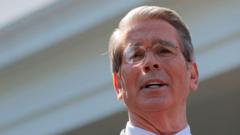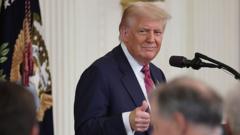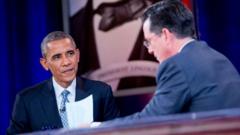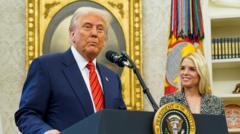Recent developments highlight the contrasting approaches within Trump's administration regarding tariffs. Future market stability may hinge on Treasury Secretary Scott Bessent's emerging role, as conflicting strategies from other key figures prompt questions about leadership coherence in trade policies.**
Navigating the Trade Turbulence: How Strategic Voices Influenced Trump's Tariff Decisions**

Navigating the Trade Turbulence: How Strategic Voices Influenced Trump's Tariff Decisions**
An analysis of the complex dynamics and shifting roles within Trump's tariff team, revealing how strategic insights swayed trade policies amidst global uncertainties.**
In an unpredictable political landscape marked by fluctuating trade policies, the dynamics within President Donald Trump's tariff team demonstrate how strategic voices have the power to sway considerable economic decisions. On April 9, amidst chaotic whispers and market anticipations, Treasury Secretary Scott Bessent emerged as the pivotal figure declaring a suspension of numerous "reciprocal" tariffs that could have spiraled into a worldwide trade war.
His prompt communication with reporters touted his decision as a courageous step, even as key figures like Commerce Secretary Howard Lutnick and trade adviser Pete Navarro, associated with a more hardline stance, were notably absent. This shift underlines a complicated interplay of power, drawing parallels to a classic "good cop, bad cop" scenario in negotiations—Bessent embodies the conciliatory tone, while Lutnick and Navarro project a more aggressive trade posture.
Bessent’s crucial influence stemmed from direct appeals to the President, including insights from his extensive background in the bond market and feedback from business leaders concerned about economic repercussions. Analysts suggest that Bessent’s ability to frame alternative pathways to achieving Trump’s objectives could mark the beginning of a less chaotic yet more effective path for trade negotiation, steering Trump’s focus back to market responses.
Moreover, the absence of other significant players such as US Trade Representative Jamieson Greer—presenting contradictory statements from White House officials—highlights an alarming disorganization in policymaking that surrendered clarity to confusion, instigating market volatility. Commentators have warned that the administration’s diverse messaging could muddy the waters, bewildering investors trying to navigate the trade landscape.
As Bessent steps into a more prominent public role, there are expectations he will help structure an increasingly coherent economic policy, providing the necessary stability for investors. Meanwhile, figures like Lutnick and Navarro will likely assume supportive roles, emphasizing varied aspects of tariff negotiations for different audiences.
Experts suggest that moving towards a more unified public strategy could help mitigate uncertainties in stock markets, which have already begun to respond positively to the recent tariff pause. With a concerted approach to economic messaging, businesses and investors may find a clearer path as they maneuver through the intricate web of global trade relations.





















